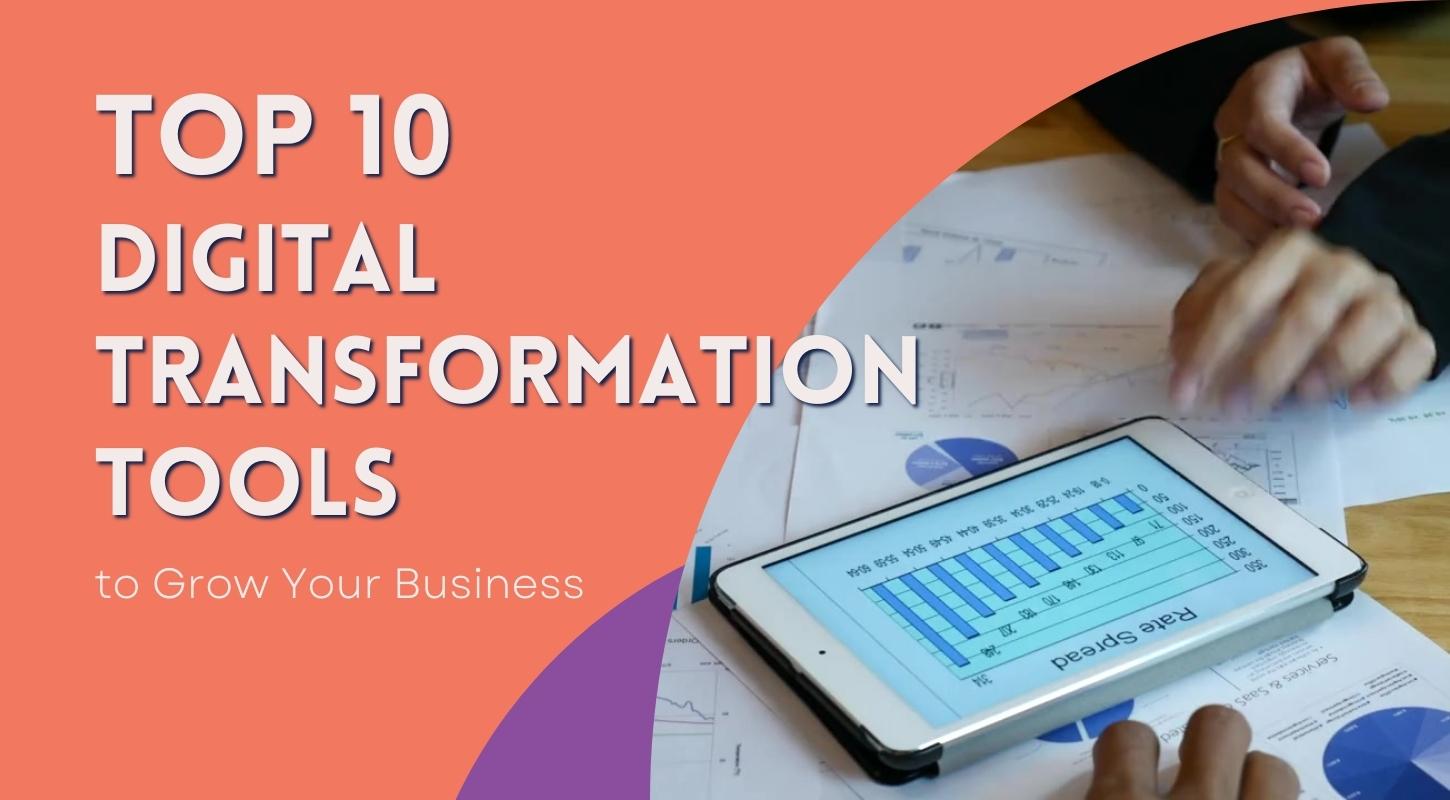Digital Transformation Tools – 10 Essential Tools to Support Your Digital Transformation
In the digital era, businesses must navigate the swiftly evolving tech landscape to stay competitive. Digital transformation, the integration of digital technology into all business areas, enhances efficiency, customer experience, and success. It demands a cultural shift towards adopting digital tools and technologies to improve processes, operations, and innovation. Key to successful transformation, these digital tools—from CRM systems and workflow management to project management solutions—help businesses fully leverage technology and maintain a competitive advantage.
In this blog, we will explore the top 10 best digital transformation tools that can help businesses achieve success in their digital workplace. We will discuss the key features, advantages, disadvantages, and pricing models of each tool. Whether you are a small startup or a large enterprise, these tools can help you navigate the digital landscape and drive growth in the digital age.
- Digital Transformation Tools – 10 Essential Tools to Support Your Digital Transformation
- What is Digital Transformation?
- Essential Digital Transformation Tools for Achieving Success
- Here are 10 digital tools to help transform your digital business strategy:
- 1. Microsoft Power Apps
- Advantages
- Disadvantages
- Is it a Free or a Paid Tool?
- 2. Evolved Metrics CRM
- Advantages
- Disadvantages
- Is it a Free or a Paid Tool?
- 3. Google Drive
- Advantages
- Disadvantages
- Is it a Free or Paid Tool?
- 4. Big Data Analytics Solutions
- 5. Intranet (link to blog post)
- 6. Artificial Intelligence and Machine Learning Tools
- 7. Internet of Things (IoT) Frameworks
- 8. Blockchain Technology
- 9. Cybersecurity Solutions
- 10. Robotic Process Automation (RPA)
- 11. Digital Accounting Tools
- Here are some specific examples of digital tools that are beneficial:
- Frequently Asked Questions
- What Factors Should Be Considered When Selecting Digital Transformation Tools?
- How Do Digital Adoption Platforms Impact Customer Experience?
- What Are the Common Challenges in Implementing Digital Transformation Tools?
- How Can Businesses Measure the Success of Digital Transformation Initiatives?
- What Is the Future of Digital Transformation in Business?
What is Digital Transformation?
Digital transformation refers to the integration of digital technologies into all aspects of a business, fundamentally changing how it operates and delivers value to its customers. It involves the adoption of digital tools, processes, and systems to optimize operations, enhance customer experience, and drive innovation.
Digital transformation requires a cultural change, where organizations embrace digital technologies and encourage their employees to adapt to new ways of working. In the digital age, businesses need to adopt a digital transformation strategy to stay relevant, remain competitive, and meet the evolving needs of their customers.
Essential Digital Transformation Tools for Achieving Success
Digital transformation tools are essential for businesses to achieve success in their digital transformation journey. These tools enable businesses to leverage technology to its fullest potential and drive growth in the digital age.
From customer relationship management – (CRM tools) to project management tools, there are a wide range of digital transformation tools available that cater to different business needs and goals. By adopting these tools, businesses can streamline processes, enhance customer experience, and stay ahead of the competition in the digital age.
Here are 10 digital tools to help transform your digital business strategy:
1. Microsoft Power Apps

Microsoft Power Apps is a low-code development platform that allows businesses to create custom business applications without the need for extensive coding knowledge. It enables businesses to build apps, automate workflows, and transform manual processes into digital solutions. With its drag-and-drop interface and pre-built templates, Microsoft Power Apps is a user-friendly tool that empowers businesses to rapidly develop and deploy custom business applications.
By using Microsoft Power Apps, businesses can streamline their project management processes, improve collaboration, and drive efficiency. This tool offers advantages such as enhanced user experience, optimized business operations, and rapid product development. However, it is important to consider the potential disadvantages and the cost of using Microsoft Power Apps, as it may require investment in training and technical expertise to ensure successful adoption and utilization of the tool.
Advantages
- User experience: Microsoft Power Apps provides a user-friendly interface and allows businesses to create custom apps with a seamless user experience.
- Business operations: This tool enables businesses to automate workflows and optimize their operations, reducing manual tasks and improving efficiency.
- Rapid product development: With its low-code development platform, Microsoft Power Apps empowers businesses to rapidly develop and deploy custom business applications, accelerating product development cycles.
- Scalability: Microsoft Power Apps is scalable, allowing businesses to start small and grow their applications as their needs evolve.
Disadvantages
- New technologies: Implementing Microsoft Power Apps may require businesses to familiarize themselves with new technologies and learn how to leverage the features and capabilities of the platform.
- Learning curve: As with any new tool, there may be a learning curve associated with Microsoft Power Apps, requiring businesses to invest time and resources in training their employees.
- Support teams: Businesses may need to rely on support teams or external experts to address technical issues or provide guidance during the implementation and utilization of Microsoft Power Apps.
- Integration complexity: Integrating Microsoft Power Apps with existing systems and processes may require technical expertise and careful planning to ensure a seamless transition.
Is it a Free or a Paid Tool?
Microsoft Power Apps offers a free plan that allows businesses to build and run apps with limited capabilities. However, for businesses that require more advanced features and functionalities, there is a paid plan available. The pricing for Microsoft Power Apps is based on a per-app and per-user basis, making it a flexible and scalable solution for businesses of all sizes. It is important to consider the specific needs and requirements of your business when determining whether the free plan or the paid plan is the right fit. Additionally, Microsoft Power Apps integrates seamlessly with other Microsoft tools, such as Microsoft Teams, enabling businesses to leverage their existing organizational structure and collaboration tools.
2. Evolved Metrics CRM

Evolved Metrics CRM (customer relationship management) is a powerful digital transformation tool that helps businesses effectively manage customer relationships, streamline sales and marketing processes, and gain actionable insights through data analytics. With its user-friendly interface and customizable features, Evolved Metrics CRM tools are suitable for small and medium-sized businesses seeking to win more opportunities and improve their sales performance.
| Key Features | Benefits |
| Automation | Integrates with email and calendar, flags important messages, and provides advanced search tools. |
| Activity tracking & follow-ups | Allows users to track client interactions and schedule follow-ups for effective customer management. |
| Infinite upgrades forever | Offers free upgrades as the CRM evolves, ensuring that businesses always have access to the latest features. |
| Tailored for you | Allows users to configure their CRM to match their unique customer journey and business processes. |
| Dashboard & reporting | Provides customizable dashboards and meaningful sales metrics to support data-driven decision-making. |
By adopting Evolved Metrics CRM, businesses can improve customer experience, drive revenue growth, automate business processes, and make informed decisions based on insightful analytics. However, it is important to consider the potential disadvantages and the cost of using this tool, as it may require investment in training and change management to ensure successful digital transformation.
Advantages
- Improved customer experience: Evolved Metrics CRM allows businesses to track and record client interactions, ensuring a personalized and seamless customer experience.
- Revenue growth: By providing meaningful analytics and forecasting sales opportunities, businesses can drive revenue growth and make data-driven decisions.
- Process automation: This CRM tool streamlines sales and marketing processes, enabling businesses to automate repetitive tasks and focus on more strategic activities.
- Configurable: Evolved Metrics CRM is highly customizable, allowing businesses to configure the tool to match their unique customer journey and business processes.
Disadvantages
- Technology adoption: Implementing a new CRM system may require businesses to invest time and resources in training their employees and ensuring smooth technology adoption.
- Change management: Introducing a new CRM tool may require businesses to navigate change management challenges and address any resistance to change among employees.
- Digital maturity: Businesses with limited digital maturity may face challenges in fully utilizing the features and capabilities of Evolved Metrics CRM, requiring additional support and training.
- Integration complexity: Integrating Evolved Metrics CRM with existing systems and processes may require technical expertise and careful planning to ensure a seamless transition.
Is it a Free or a Paid Tool?
Evolved Metrics CRM offers a free trial period for businesses to test the tool and experience its features and capabilities. However, after the trial period, it is a paid tool with a monthly subscription cost. The pricing for Evolved Metrics CRM starts at $25 per user per month, making it a cost-effective solution for small and medium-sized businesses seeking to improve their sales performance and customer management. While there is a cost associated with using Evolved Metrics CRM, it offers a range of features and benefits that can contribute to a successful digital transformation, making it a worthwhile investment for businesses looking to enhance their customer relationships with improved communication tools and drive revenue growth.
3. Google Drive

Google Drive is a versatile cloud storage solution that enhances collaboration within digital transformation projects. Its user-friendly interface simplifies file sharing and document management for team members. The main advantage lies in its free version, making it a cost-effective choice for businesses. However, limited storage capacity could be a drawback for extensive data needs. Google Drive seamlessly integrates with other digital tools, promoting efficient workflow and enhancing productivity.
Advantages
- Collaboration: Google Drive enables seamless collaboration among team members, allowing them to work on files together in real-time.
- Remote access: With Google Drive, businesses can access their files from any device with an internet connection, enabling remote work and flexibility.
- User-friendly: Google Drive offers a user-friendly interface and intuitive features, making it easy for businesses to adopt and utilize the tool.
- Additional storage: Google Drive provides businesses with additional storage options, allowing them to store and manage large files and data sets.
Disadvantages
- Privacy concerns: Businesses need to consider the privacy implications of storing and sharing files on a third-party platform like Google Drive and ensure compliance with data protection regulations.
- Dependency on internet: Google Drive requires an internet connection for accessing and collaborating on files, which may be a disadvantage in areas with unreliable or limited internet access.
- Data security: While Google Drive provides secure storage and encryption, businesses need to implement appropriate access controls and security measures to protect their files and data.
- Learning curve: Adopting Google Drive may require employees to learn new tools and processes, resulting in a learning curve that needs to be managed.
Is it a Free or Paid Tool?
Google Drive offers a free plan that provides businesses with 15GB of storage. For businesses that require additional storage, there are paid plans available with varying storage options. The pricing for additional storage depends on the size of the storage plan and the number of users. Businesses can choose the plan that best suits their storage needs and budget. It is important to consider the specific storage requirements of your business when determining whether the free plan or a paid plan is the right fit. Additionally, Google Drive offers flexible pricing models, allowing businesses to scale their storage and pay only for the storage they need.
4. Big Data Analytics Solutions

Big data analytics solutions enable businesses to analyze large volumes of data to gain valuable insights and make data-driven decisions. These solutions utilize advanced analytics techniques, such as machine learning and artificial intelligence, to identify patterns, trends, and correlations in data that can help businesses optimize operations, improve customer experience, and drive innovation.
By leveraging big data analytics solutions, businesses can gain a deeper understanding of customer behaviour, preferences, and needs, allowing for personalized and targeted marketing strategies. These solutions also enable businesses to optimize their supply chain, forecast demand, and make informed decisions based on accurate and reliable data. However, businesses need to consider the potential challenges associated with implementing and managing big data analytics solutions, such as data privacy and security, talent acquisition, and data integration.
5. Intranet (link to blog post)

The intranet, a private network accessible only to an organization’s staff, has evolved significantly to become a crucial tool in the digital transformation journey of businesses. Traditionally used for internal communication and information sharing, modern intranets have transformed into comprehensive platforms that support collaboration, knowledge management, and integration with various business applications. This evolution enables employees to access a wide range of tools and resources from a single interface, improving efficiency and productivity. Furthermore, by facilitating smoother communication channels, fostering a culture of openness and collaboration, and providing personalized content and services, intranets enhance employee engagement and satisfaction.
They also play a vital role in streamlining processes, providing social intranet tools, automating routine tasks, and providing employees with real-time data and analytics, which are essential for making informed decisions. In the era of remote and hybrid work, the intranet has become even more important, serving as a digital hub that connects dispersed teams, maintains corporate culture, and ensures that all employees have access to the information and tools they need to perform their roles effectively.
Related article: What is an Intranet and How an it Help my Business?
6. Artificial Intelligence and Machine Learning Tools

Artificial intelligence (AI) and machine learning (ML) tools are revolutionizing the way businesses operate and make decisions. These tools enable businesses to automate tasks, analyze vast amounts of data, and make predictions and recommendations based on patterns and trends in the data.
AI and ML digital tools can be used in various business applications, such as customer service, fraud detection, and demand forecasting, to improve efficiency, accuracy, and decision-making. By leveraging AI and ML tools, businesses can automate manual tasks, enhance customer experience, and optimize operations. However, it is important to consider the potential challenges associated with AI and ML, such as data privacy and bias, and ensure that these tools are implemented and used responsibly and ethically.
Example – ChatGPT (see section below for details)
7. Internet of Things (IoT) Frameworks

Internet of Things (IoT) frameworks enable businesses to connect and communicate with smart devices and sensors to collect data and automate processes. These frameworks facilitate the integration of physical devices with digital systems, allowing businesses to monitor and control various aspects of their operations in real-time.
By leveraging IoT frameworks, businesses can optimize energy consumption, improve asset management, and enhance operational efficiency. For example, in manufacturing, IoT frameworks can enable predictive maintenance by monitoring equipment performance and alerting maintenance teams when repairs are needed. However, businesses need to consider the potential challenges associated with IoT, such as data security and privacy, scalability, and interoperability.
8. Blockchain Technology

Blockchain technology offers businesses a decentralized and transparent way to record and verify transactions. It enables the secure and tamper-proof storage of data, providing businesses with increased transparency and trust in their operations.
By leveraging blockchain technology, businesses can streamline supply chain processes, improve traceability and accountability, and enhance data security. For example, in the financial industry, blockchain technology can enable secure and efficient cross-border transactions. However, businesses need to consider the potential challenges associated with blockchain technology, such as scalability, regulatory compliance, and integration with existing systems.
9. Cybersecurity Solutions

Cybersecurity solutions are essential for businesses to protect their data and systems from cyber threats. These solutions encompass a range of tools and practices that help businesses prevent, detect, and respond to security incidents.
By implementing cybersecurity solutions, businesses can protect their data from unauthorized access, ensure compliance with regulations, and mitigate the risk of cyber attacks. These solutions include antivirus software solutions, firewalls, encryption, and secure network protocols. However, businesses need to consider the evolving nature of cybersecurity threats and the need for ongoing monitoring and updates to ensure the effectiveness of their cybersecurity measures.
10. Robotic Process Automation (RPA)

Robotic Process Automation (RPA) enables businesses to automate repetitive and rule-based tasks by using software robots. These robots can mimic human actions and interact with various digital systems, reducing manual errors and increasing operational efficiency.
By adopting RPA, businesses can automate tasks such as data entry, data processing, and report generation, freeing up employees’ time to focus on more strategic activities. RPA can improve efficiency, accuracy, and productivity, leading to cost savings and improved customer service. However, businesses need to consider the potential challenges associated with RPA, such as the need for process standardization, integration with existing systems, and the impact on employee roles and responsibilities.
And here’s one more just because ….
11. Digital Accounting Tools

Digital accounting tools enable businesses to automate their accounting processes, improve accuracy, and streamline financial reporting. These tools provide businesses with real-time insights into their financial performance and enable them to make data-driven decisions.
By leveraging digital accounting tools, businesses can automate tasks such as invoicing, expense tracking, and financial reporting, reducing the risk of human error and improving efficiency. These tools also facilitate collaboration between finance teams and other departments, ensuring accurate and up-to-date financial information. However, businesses need to consider the potential challenges associated with digital accounting tools, such as data security and privacy, and the need for proper training and integration with existing systems.
Here are some specific examples of digital tools that are beneficial:
1. ChatGPT
ChatGPT, is a sophisticated AI model capable of generating human-like text responses. It excels in tasks like answering questions, creating content, and simplifying complex information, making it a versatile tool across various fields. Benefits include instant access to information, enhanced productivity, creativity stimulation, and the automation of repetitive tasks like drafting emails or generating reports, significantly aiding in education, business, and more.
1. Workday
Workday is a comprehensive digital tool that excels in human capital management (HCM) software. It streamlines essential HR processes, including employee data management, payroll management tools, and benefits administration. Its user-friendly interface enhances team collaboration and boosts productivity. Workday offers a cloud-based solution, ensuring easy access for remote work setups. Despite its benefits, Workday may require significant training for full utilization. It is a paid tool offering various pricing plans to cater to different business needs.
2. Payfit
Payfit is a comprehensive digital tool that streamlines HR processes efficiently. It simplifies payroll management, employee records, and compliance tasks, enhancing organizational productivity. While Payfit offers convenience and time savings, its pricing structure may be a drawback for smaller businesses. Payfit’s user-friendly interface and integration capabilities make it a valuable asset for digital transformation initiatives. Considering its focus on HR management, Payfit is a paid tool essential for optimizing human resource operations in the digital age.
3. Bamboo HR
Bamboo HR is a comprehensive human capital management (HCM) platform that helps businesses manage their HR processes, including employee data management, recruitment, onboarding, and performance management. It provides businesses with a centralized platform for managing their workforce and streamlining HR operations.
By adopting Bamboo HR, businesses can automate HR processes, improve employee engagement, and enhance overall workforce management. Bamboo HR offers features such as applicant tracking, employee self-service portals, and performance management tools, enabling businesses to attract, develop, and retain top talent. However, businesses need to consider the potential challenges associated with implementing Bamboo HR, such as the need for proper training and change management to ensure successful adoption and utilization.
Frequently Asked Questions
What Factors Should Be Considered When Selecting Digital Transformation Tools?
When selecting digital transformation tools, businesses should consider factors such as their business goals, scalability of the tools, user adoption, cost, and the availability of support. It is important to choose tools that align with the specific needs and goals of the business and can support its digital transformation journey.
How Do Digital Adoption Platforms Impact Customer Experience?
Innovative digital tools can significantly impact customer experience by improving customer satisfaction, enhancing user experience, enabling efficient customer support, and enabling personalized products and services. These tools streamline processes, provide valuable insights, project management tools and communication tools that and enable businesses to deliver exceptional value to their customers.
What Are the Common Challenges in Implementing Digital Transformation Tools?
Common challenges in implementing digital transformation tools include resistance to change among employees, the need for training and upskilling, and the complexity of integrating new tools with existing systems. It is important for businesses to address these challenges through effective change management strategies and proper training and support.
How Can Businesses Measure the Success of Digital Transformation Initiatives?
Measuring the success of digital transformation initiatives is essential for businesses to evaluate their progress and make informed decisions. Key performance indicators (KPIs) such as increased revenue, improved customer satisfaction, and decreased operational costs can indicate the success of digital transformation efforts. Return on investment (ROI) analysis helps determine the financial benefits of digital transformation investments. Additionally, gathering customer feedback through surveys or online reviews can provide insights into the impact of digital transformation on customer experience.
What Is the Future of Digital Transformation in Business?
The future of digital transformation in business is promising, with innovative solutions and emerging technologies shaping the way organizations operate. AI, machine learning, and the Internet of Things are revolutionizing business processes, enabling automation, and improving decision-making. Adopting digital transformation strategies offers a competitive advantage by enhancing efficiency, agility, and customer experience. As technology continues to evolve, businesses must stay adaptable and embrace digital transformation to thrive in the future.


